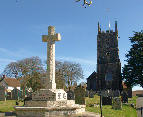Thomas Lugg was born in 1885 in Winkleigh, the second son of Thomas Lugg, a general labourer who had been born at Dolton, and his wife Jane Coombe, also born at Dolton. In 1901 the family were living in Moor View, Winkleigh, and consisted of Herbert, aged 22 and a general worker, Blanche aged 11 and Gilbert aged 5.
At this time, Thomas, originally employed as a grocer’s carter, was living in Exeter. In 1909 he married Alice, formerly Hammett and born in Coldridge, and was living in the village. The 1911 census shows he had a son, Thomas John aged 1.
A daughter, Ella Elizabeth, was born on 1st march 1914, when his profession was reported as a road contractor, probably employing his brother Herbert. The Chumleigh Deanery magazine reported that Thomas Lugg, then aged 30, had attempted to volunteer in 1914, but had been rejected. The Roll of Honour, however shows that he was later enlisted into the Rifle Brigade, and thankfully survived
The Rifle Brigade is also known as The Green Jackets. Originally formed in the 18th Century as front line troops, the green jackets they wore were an early form of camouflage, which compared to other regiments of red-coats became a jealously guarded tradition. The Brigade marches at 140 paces per minute compared to the normal 120 paces, another source of pride and tradition.
In the First World War, besides 4 Regular Army battalions, backed by 2 training and reserve battalions, there were no less than 7 Territorial battalions formed by the Rifle Brigade, numbered 18th – 24th.. In accordance with an Army Council Instruction on 29th November 1915, these Territorial battlions were formed originally from National Reservists who were used for guarding vulnerable points in the UK. Thomas' medal card shows that he had already served pre-war as a regular in the Rifle Brigade, with the number 952. In 1914 he had tried in 1914 to re-enlist as an Army Reservist in the same regiment but was presumably regarded as unfit. Later his re-enlistment was accepted. This could have resulted from his volunteering under the Derby scheme, under which a man could still choose a unit in which to serve. Thomas would have realised that conscription was very likely, and early registration would have assured him an enlistment in the regiment of his choice. We know that he was able to select direct entry into the Territorials, (normally not possible after the introduction of conscription), a concession offered because of his earlier service in the Rifle Brigade, which secured his re-enlistment as an ex-army reservist.
The Rifle Brigade Territorial battalions consisted of 18th (London), 19th (Western), 20th (Northern), 21st (Midland)), 22nd (Wessex and Welsh), 23rd (North Eastern) and 24th (Home Counties). The War Medal roll for the Rifle Brigade shows that Thomas was enlisted into the 24th Battalion., and that he served from 5th November 1916 until demobilisation on 1st November 1919.
Thomas re-enlisted under his original number 952. Then, on 1st March 1917 all men serving in the Territorial Army were re-numbered. The Rifle Brigade were allocated numbers 200,001 to 300,000. Thomas received his second number, 206995.
After training and service in the UK, the Rifle Brigade Territorial Battalions were finally posted for Garrison Service overseas in 1916. The 18th, 23rd and 24th went to India, and the 19th and 20th to Egypt. The 21st went to India via Egypt ,and the 19th Battalion and the 22nd to Salonica via Egypt. Thomas therefore served in India. Sadly, no war diaries were kept by battalions employed on garrison service in India, since India was not regarded as a war-zone, and so it is not possible to give further details of the activities or location of the 24th Battalion.
Thomas was entitled to receive the British War Medal, which was finally awarded to him on 28th August 1920.
20th March 2018


